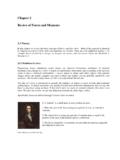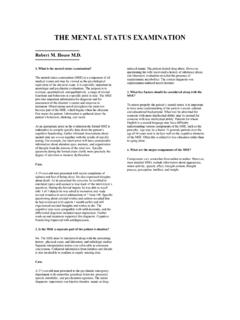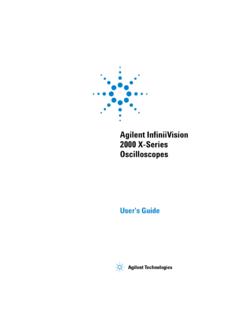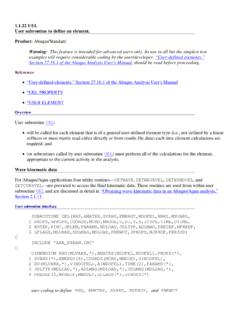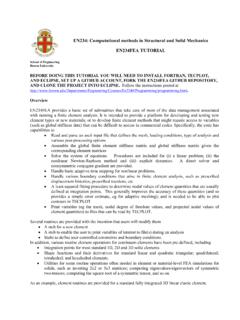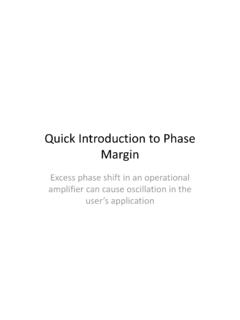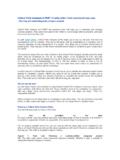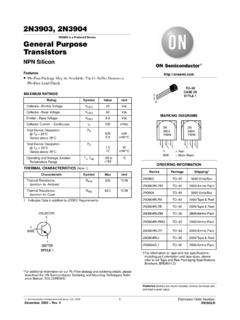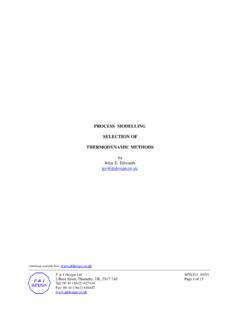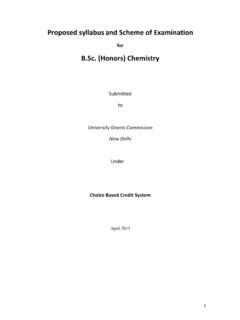Transcription of TheAlloy-TheoreticAutomatedToolkit(ATAT):AUserGuide
1 The Alloy-Theoretic Automated Toolkit (ATAT): A User GuideAxel van de WalleMarch 9, 20192 Chapter 1 Features/CapabilitiesThe Alloy-Theoretic Automated Toolkit (ATAT) is a generic name that refers to a collection of alloy theory tools: Codes to construct cluster expansions from first-principles (maps and mmaps). A cluster expansion is a verycompact and efficient expression giving the energy of an substitutional alloy as a function of its configuration( which type of atom sits where on the lattice). Codes to perform Monte Carlo simulation (emc2 and memc2) of lattice models in order to compute thermody-namic properties of alloys, starting from a cluster expansion. Codes to perform lattice dynamics calculations (fitfc, fitsvsl, svsl) Codes to calculate electronic and magnetic free energy contributions (felec, fmag, fempmag) using simplephysical or semiempirical models.
2 Utilities to combine all of the above to generate free energies that include configurational, vibrational andelectronic contributions (mkteci). Codes to generate Special Quasirandom Structures (SQS), tomodel disordered solid solutions (mcsqs, gensqs)and to enumerate structures (genstr). A large library of pre-computed SQS and structure prototypes. Extension of the two above tools that allow the constructionof so-called reciprocal-space cluster expansion,which are useful to model the energetics of alloys exhibiting a large atomic size mismatch. Tensorial cluster expansions (gce). Elastic constant calculations (calcelas). Structure conversion utilities (subcells, supercells, coordinate system changes, file format, etc.) (cellcvrt,wycked, etc.)
3 Scripts to automate tasks (foreachfile, sspp, getvalue, getlines, etc.). Codes to generate CALPHAD databases (sqs2tdb). Utilities to interface the above tools with first-principles codes, such as VASP (runstructvasp, runstructabinit,runstructgulp, etc.). Job control utilities that enable the efficient use of a cluster of workstations to run the first-principles codesthat provide the input to the above codes (pollmach).34 CHAPTER 1. FEATURES/CAPABILITIESC hapter 2 Credits and LicenceThe Alloy-Theoretic Automated Toolkit (ATAT)1is a generic name that refers to a collection of alloy theory toolsdevelopped by Axel van de Walle2, in collaboration with various research Collaborators and CreditsThe MAPS3(MIT Ab-initio Phase Stability) code, which automaticallyconstructs a cluster expansion from theresult of first-principles calculations, was developped byAxel van de Walle in collaboration with Prof.
4 Gerd Ceder sgroup4from the Department of Materials Science and Engineering atthe Massachusetts Institute of consists of the following codes: maps, corrdump, genstr, checkcell, kmesh, EMC2 (Easy Monte Carlo Code), which automate the calculation of alloy thermodynamic properties viaMonte Carlo simulations of lattice models, were developpedby Axel van de Walle in collaboration with Prof. MarkAsta s group5from the Department of Materials Science and Engineering atNorthwestern University. EMC2 consistsof the following codes: emc2, CSE (Constituent Strain Extension) to both the MAPS and EMC2 codes, which implement the constituentstrain formalism based on a reciprocal-space cluster expansion, was developped by Axel van de Walle in collaborationwith Alex Zunger s Solid State Theory Group6at the National Renewable Energy Laboratory in Golden, Coloradoand in collaboration with Gus Hart7from the Department of Physics and Astronomy at Northern Arizona conssists of the following files.
5 , , D Avezac at NREL has provided all the changes needed for ATAT to compile with g++ versions andlater as well as intel s c++ Blum at NREL has contributed to improve the portability of the package by providing aperlversion Shin at Penn State has converted a large number of common lattices (found at the NRL navy website8) into theatatformat. See Pomrehn has improved the efficiency of the structure enumeration algorithm and contributed the Kristensen has been quite active on the ATAT forum, helping me answer queries. He also maintains somedocumentation on his web site9 Ruoshi Sun has also answered many queries on the ATAT B aker has written a simple and useful tutorial for ATAT s emc2 and phb tools for computing phasediagrams via Monte avdw/atat/2 avdw/3 avdw/maps4 hart/8 2.
6 CREDITS AND LICENCEThe FFT routines in the files and were obtained from the package available fromNetlib10. The origin of these routines dates back to a FORTRAN code by R. C. Singleton in 1968 [19], later convertedto C and subsequently improved by Mark Olesen and John Beale in 1995. These routines are included in theatatpackage for sole purpose of providing users with the convenience of avoiding a separate download. Axel van de Walledoes not claim any ownership of them or intellectual credit for of the basic numerical routines were inspired by Numerical Recipes in C, although they were completelyre-written according to the ATAT code style conventions, for instance to use 0-indexed arrays and make better useof C++ Perl routines Permutor (written by Tom Phoenix) and PowerSet (written by David Landgren) were down-loaded from the free software resource and included in this distribution simply to avoid users a Zhe has contributed an interface to PWSCF (aka Quantum Espresso)
7 That can be found in atat/glue/qeMatt Probert has contributed an interface to CASTEP that canbe found in atat/glue/ Financial SupportThe development of MAPS was supported by the Departmentof Energy, Office of Basic Energy Sciences, undercontract no. DE-F502-96ER 45571. Gerbrand Ceder acknowledges support of Union Mini`ere through a FacultyDevelopment Chair. Axel van de Walle acknowledges support of the National Science Foundation under programDMR-0080766 and DMR-0076097 during his stay at Northwestern development of EMC2 was supported by the NSF under program development of the CSE is supported by the NSF under program development of the tensorial cluster expansion (GCE andgencs code) is supported by the Center for theScience and Engineering of Materials at Caltech, an NSF-funded MRSEC and by the NSF CMMT grant development of the wycked and getproto codes is supported by the NSF CAREER grant development of the mcsqs code is supported by ONR grants N00014-11-1-0886 and development of the sqs2tdb, robustrelaxvasp, infdet and of the SQS database is supported by ONR grantsN00014-14-1-0055 and License and AgreementsThis work is licensed under a Creative Commons Attribution-NoDerivatives International refer to this link12for a detailed description of this license.
8 In the context ofthe ATAT package, some ofthe license terms are explained further below. No derivative indicates that you cannot redistribute a modified version of the ATAT package. However, theauthors of ATAT do not consider the use of ATAT as a library called from another code as derivative work , aslong as this can be done without modifying ATAT s source code. If your software package makes use of ATAT, westrongly recommend that you provide a link to the ATAT download page13instead of including a copy of the ATAT distribution with your own distribution, to ensure that users have the latest version. Users are free to modify thecode solely for their personal use ( without re-distributing it) and are encouraged to share their improvementswith the author at Their contributions will be acknowledged in the present section, infuture versions of this manual.
9 Attribution indicates that, if you use ATAT, you should give appropriate credit. In particular, any scientificwork whose results were obtained with the codes described above must properly acknowledge their use by citing thefollowing papers (a BibTeX file is available LICENSE AND AGREEMENTS71. A. van de Walle and G. Ceder, Automating First-Principles Phase Diagram Calculations16 ,Journal of PhaseEquilibria,23, 348, (2002).2. A. van de Walle and M. Asta, Self-driven lattice-model Monte Carlo simulations of alloy thermodynamicproperties and phase diagrams17 , modelling Simul. Mater. Sci. , 521, (2002).3. A. van de Walle, M. Asta and G. Ceder, The Alloy Theoretic Automated Toolkit: A User Guide18 CALPHADJ ournal,26, 539, (2002).)
10 4. A. van de Walle, Multicomponent multisublattice alloys, nonconfigurational entropy and other additions tothe Alloy Theoretic Automated Toolkit19 ,Calphad Journal33, 266, (2009).5. As of version , the algorithm to generate superstructures has been improved based on the ideas in G. Hart and R. W. Forcade, Algorithm for generating derivative structures20, Phys. Rev. B77, 224115,(2008).6. If themcsqscode is used: A. van de Walle and P. Tiwary and M. M. de Jong and D. L. Olmsted and M. and A. Dick and D. Shin and Y. Wang and Chen and , Efficient stochastic generation ofSpecial Quasirandom Structures21,Calphad Journal42, 13 (2013).7. If the constituent strain extension is used: D. B. Laks andL. G. Ferreira and S. Froyen and A.
